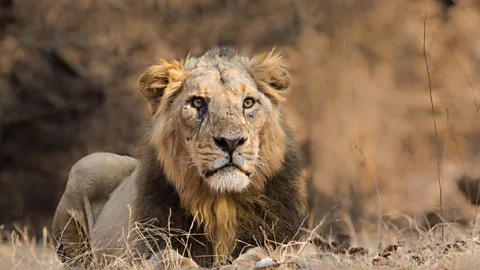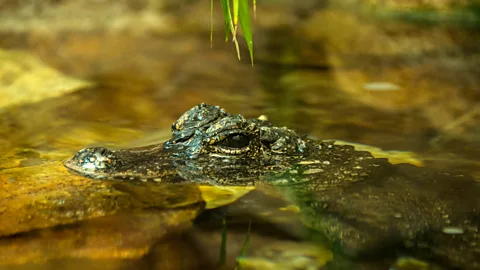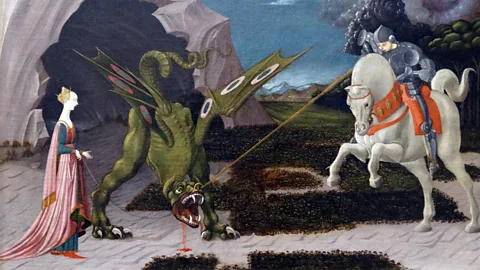Wise, lucky, terrifying: The surprising 4,000-year history of dragons
 Getty Images
Getty ImagesFrom dragon-like animals to Chinese tornados and quaint English villages, here are the real-life traces of an ancient myth.
Today marks the Lunar New Year heralding the year of the dragon – or does it? The Chinese word "lóng", or 龍, is usually translated into English as "dragon". But don't let the connection mislead you: lucky, ethereal Chinese dragons are very different beasts to the stomping, fire-breathing monsters of English mythology.
They are associated with wind rather than fire, for a start – the Chinese word for tornado (lóng juǎn fēng) translates word for word as "swirling-dragon-wind". And Chinese dragons are also different to the regal Sumerian "ušum-gal", a mythical, lion-jawed, snake-bodied creature from the ancient Middle East. Around the world, and in many different languages, people have come up with words that more or less mean dragon – but how they picture them, and whether they see these beings as sacred, friendly, deadly, or just a bit annoying, varies hugely across cultures.
These dragon-like creatures do have one thing in common: they tend to share traits with real-life animals, and reflect our interactions with and feelings about the natural world. Here's a trip through history in pursuit of these global dragon myths and their real-life inspiration – and what they can teach us about our own relationship with nature.
 Getty Images
Getty ImagesThe oldest word for dragon?
More than 4,000 years ago, a scribe in ancient Mesopotamia – the Middle Eastern region that is now part of Iraq – wrote a curious word on a clay tablet: "ušum-gal". The word is in Sumerian, humanity's oldest written language, and is believed to be the oldest known word for dragon. It's composed of the words "gal" (big) and "ušum" ("snake").
But what kind of creature is an "ušum-gal", actually – and does it have a still-living, real-life counterpart in the Middle East?
Sumerian texts suggest it was a mythical creature inspired by snakes but also lions, says Jay Crisostomo, a professor of ancient Middle Eastern civilisations and languages at the University of Michigan, whose work includes deciphering and translating original Sumerian clay documents.
"It is one of several mythical creatures [in Sumerian culture] that combined various animals and typically conveyed traits related to wisdom, power and protection," he says. "The ušum-gal is especially noted for its mouth, so presumably had a large, gaping maw."
 Getty Images
Getty ImagesIn Sumerian texts, the word ušum-gal is often used as a metaphor for a lion or in conjunction with lions as part of a royal fearsome trait, Crisostomo continues. "For example a hymn to the moon god Suen proclaims: 'Born in the mountains and coming forth in joy, he is a powerful force, a lion, a 'dragon' (ušum-gal), a mighty lord. Suen, (with a) mouth like a 'dragon's', ruler of Ur!'"
The word also depicts a creature that rules over others and can only be defeated by the most powerful humans, he adds: "Some stories envision the god or the king as so powerful that even ušumgal do not dare leave the plains/desert or step into his path. I imagine that the ušum-gal was probably originally a type of lion or other wild carnivore and gradually adopted more mythological associations over hundreds of years."
Sumerian does not have any modern-day descendants. But speakers of Akkadian, an ancient Semitic language related to modern-day Arabic and Hebrew, borrowed the Sumerian word and used it as "ušumgallu", which has been translated as 'lion-dragon', Cristostomo says. In Akkadian culture, this lion-dragon creature was worshipped as a divine being, he says: "Another mythological dragon creature in Akkadian is mušhuššu (loaned from Sumerian muš huš 'fierce snake'); this creature is translated 'dragon' and is famously depicted on the Ishtar Gate from Babylon."
He concludes: "So is ušum-gal the oldest known word for dragon? Possibly. It was certainly a creature with traits that overlap our idea of dragons. A powerful, awe-inspiring creature that gods and kings would happily be associated with, a creature imbued with legend and a bit of mystery. If that's a dragon, then a dragon is an ušum-gal."
Lion statues and carvings from that era have survived into the modern day. A reconstruction of the Ishtar Gate, with some remaining fragments of it from its original home in Babylon, is now in a museum in Berlin. But what of the real-life lions that once roamed the ancient Middle East? We can't know for sure exactly which lion the Sumerians were referring to. But two Asian lion subgroups that were once relatively widespread are now mostly extinct, except for a small population in India.
 Getty Images
Getty ImagesLet's Talk
Let's Talk is a month-long series of language coverage across BBC.com, exploring the ancient roots of alphabets, jargon-busting the modern boardroom, and seeking to understand why we speak the way we do. Browse the whole series here.
China's dragon of change
While English dragons spew fire and do battle with angels, Chinese dragons are sacred beings. Soaring wingless through the clouds, expelling wind not flames, they symbolise luck and blessings.
Numerous academic theories exist as to the origin of the mythic Chinese dragon, says Marco Meccarelli, a lecturer at the University of Catania in Italy. These start with the idea that they were totemic symbols used by some prehistoric clans – and were inspired, in turn, by real-world snakes, or perhaps a giant oceanic python. When this tribal society became class-based, Meccarelli writes in Discovering the Long, the dragon became a symbol of rulers.
A second set of theories links the legends to a crocodilian species, such as the Chinese alligator. Seven thousand years ago, the marshy floodplains of the lower Yangtze River was an alligator haven. But as farmers turned their habitat into rice fields, the species declined. Today it is among the most endangered crocodilians in the world.
Dragon images may have evolved from attempts to replicate the noise and spiralling forms of thunder and lightning, and were prayed to for good weather, says Meccarelli. This weather link could help explain the linguistic association of tornadoes and swirling dragons in Chinese, as mentioned before. Alternatively, the fourth approach, according to Meccarelli, suggests dragons evolved from the worship of nature itself and they are an amalgamation of numerous animals and weather phenomena.
Roel Sterckx, professor of Chinese history, science and civilisation at the University of Cambridge, supports this latter theory – and is sceptical about attempts to link Chinese dragons to individual real-life animals. "A great deal of nonsense has been written on the origins of the Chinese dragon, ranging from scientists trying to identify it as some type of alligator or other amphibian to epigraphers trying to interpret the graph for 'long' as a pictograph of some sort of reptilian creature," he tells the BBC. "The truth is all of this is speculation and the main point is that the Chinese dragon is a hybrid incorporating features and locomotion of all animals in one." In other words, the dragon is an embodiment, not of a singular entity, but of the very capacity for change.
 Getty Images
Getty ImagesEngland's "dragon villages"
In AD793, "fiery dragons" soared across Northumbrian skies – a bad omen. A vicious and devastating Viking raid followed on the northern English island of Lindisfarne, sending shockwaves across Europe.
Anglo-Saxon stories are rife with ferocious dragons, slumbering in dens beneath hills, guarding their treasure. The legends live on in many English place names. Take Dragley Beck, a hamlet in Lancashire, and Drakelow, a village in Derbyshire. Both could mean "dragon's mound", or "dragon-hill".
Historically, English has two common words for dragon: dragon, and the now rarely-used, ancient word wyrm. The word "dragon" is derived from the Latin "draco" meaning serpent, or sea fish. Meanwhile, in Christian religious texts, "dragon" also referred to the devil. This mythological creature took on different qualities and shapes throughout history, for example as a fire-breathing dragon called a "firedrake".
"Wyrm", on the other hand, is a slithering, crawling creature, not a winged, flying, fiery one one. "Wyrm" also referred to parasites, snakes and grave-dwelling creatures in early medieval England. It inspired myths such as that of the child-eating Lambton Worm. This creeping creature was more common in English folklore than the winged version, and lurked in caves, marshes or fens.
"The wyrm has no legs, but slithers like a serpent," says Carolyne Larrington, professor of medieval European literature at the University of Oxford. It is different from the fiery, winged monsters: "The firedrake can fly and shoot flames," Larrington adds, "while the wyrm spits poison".
Real-life snakes, says Larrington, may have inspired the myths. "People have [also] suggested that dinosaur fossils might have played a part. But there's no real correlation between dragon stories and fossil finds," she says. A snake-inspired myth may have made its way to England from abroad: there is some evidence that the dragon motif has migrated with the movement of humans.
Today, Britain’s only venomous snake, the adder, is in decline with intensive agriculture destroying habitats and causing populations to become fragmented and isolated. English dragons on the other hand, says Larrington, are usually invulnerable and symbolise power. "You have to find their weak spot to kill them," she says.
Whether your own idea of dragons is as swirling, spiralling symbols of luck or as giant slithering worms, the Lunar New Year could be a good opportunity for looking out for their traces in your own language, everyday life and environment – and perhaps, marvel at the collective act of imagination and appreciation of nature that gave rise to these fabulous creatures.
Reporting by India Bourke, Katherine Latham and Sophie Hardach
--
If you liked this story, sign up for The Essential List newsletter – a handpicked selection of features, videos and can't-miss news delivered to your inbox every Friday.
